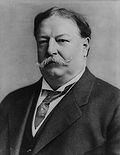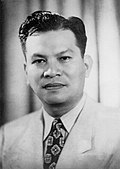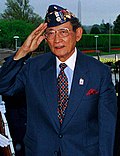Top Qs
Timeline
Chat
Perspective
List of sovereign state leaders in the Philippines
From Wikipedia, the free encyclopedia
Remove ads
The types of sovereign state leaders in the Philippines have varied throughout the country's history, from heads of ancient chiefdoms, kingdoms and sultanates in the pre-colonial period, to the leaders of Spanish, American, and Japanese colonial governments, until the directly elected president of the modern sovereign state of the Philippines.
Remove ads
Remove ads
Archaic (pre-hispanic) Era
Before the nation of the Philippines was formed, the area of what was now the Philippines during the pre-colonial times was sets of divided nations ruled by Kings, Chieftains, Datus, Lakans, Rajahs and Sultans in Southeast Asia. It was when the Spaniards arrived that they named the collections of areas they conquered and unite in Southeast Asia as "Las Islas Filipinas" or The Islands of the Philippines.
Remove ads
Legendary rulers
- Legendary rulers can be found in the oral tradition in Philippine Mythology, which having an uncertain historical/archeological evidence of their reign.
Remove ads
Archaic rulers
Summarize
Perspective
Pangasinan (historical polity)
Historical rulers of Tondo
,
Recorded rulers of Namayan
The datus of Madja-as
The Datus of Katugasan
The Datus of Dapitan
Rulers of Maynila
Monarchs of the Butuan Rajahnate
Rajahs of Cebu
Sultans of Maguindanao
The Sultans of Sulu (1405–present)
Remove ads
Philippines Era
The collection of islands conquered by the Spaniards was named Las islas Filipinas; a name given by Ruy López de Villalobos. It's the exact geographical location on which the modern day Republic of the Philippines based its territory.
Rulers during the Spanish colonization
Summarize
Perspective
During the Spanish colonization, Remaining monarchs reign until their kingdoms was absorbed to the new colonial nation of the Philippines through Spanish conquest. Many of these territories are absorbed much later.
- Rajah Colambu – King of Limasawa in 1521, brother of Rajah Siagu of Butuan. He befriended Portuguese explorer Ferdinand Magellan and guided him to Cebu on April 7, 1521.
- Rajah Humabon – Rajah of Cebu who became an ally of Ferdinand Magellan and the Spaniards. Rival of Datu Lapu-Lapu. In 1521, he and his wife were baptized as Christians and given Christian names Carlos and Juana after the Spanish royalty, King Carlos and Queen Juana.
- Sultan Kudarat – Sultan of Maguindanao
- Lakandula – Lakan of Tondo
- Datu Lapu-Lapu – King of Mactan Island. He defeated the Spaniards on April 27, 1521.
- Datu Iberein – A datu of Samar at around 1543.
- Datu Sikatuna – King of Bohol in 1565. He made a blood compact with Spanish explorer, Miguel López de Legazpi.
- Datu Pagbuaya – King of Bohol. He governed with his brother Datu Dailisan, a settlement along the shorelines between Mansasa, Tagbilaran and Dauis, which was abandoned years before the Spanish colonization due to Portuguese and Ternatean attacks. He founded Dapitan in the northern shore of Mindanao.
- Datu Dailisan – King of Mansasa, Tagbilaran and Dauis and governed their kingdom along with his brother Datu Pagbuaya. His death during one of the Portuguese raids caused the abandonment of the settlement.
- Datu Manooc – Christian name – Pedro Manuel Manooc, son of Datu Pagbuaya who converted to Christianity, defeated the Higaonon tribe in Iligan, Mindanao. He established one of the first Christian settlements in the country.
- Rajah Siagu – Rajah of Butuan
- Apo Noan – Chieftain of Mandani (present day Mandaue) in 1521
- Rajah Sulayman – The heir apparent of the Kingdom of Luzon, was defeated by Martín de Goiti, a Spanish soldier commissioned by López de Legazpi to Manila.
- Rajah Tupas – Rajah of Cebu, conquered by Miguel López de Legazpi
- Datu Zula – A datu of Mactan, rival of Lapu-lapu
- Datu Kalun – Ruler of the Island of the Basilan and the Yakans in Mindanao, converted his line to Christianity
- Datu Sanday – Ruler of Marawi City
- unnamed Datu – King of Taytay Palawan. Mentioned by Pigafetta, chronicler of Magellan. The king, together with his wife were kidnapped by the remnant troops from Magellan's fleet after fleeing Cebu to secure provisions for their crossing to the Moluccas.
- Datu Cabaylo (Cabailo) – The last king of the Kingdom of Taytay
Remove ads
During Revolts against Spain (1660–1661)
Remove ads
British Occupation of Manila (1762–1764)
Great Britain occupied Manila and the naval port of Cavite as part of the Seven Years' War.
Independent Ilocos (1762–1763)
Under New Spain (1764–1821)
Emperor
Remove ads
Spanish East Indies (1821–1898)
After the 1821 Mexican War of Independence, Mexico became independent and was no longer part of the Spanish Empire. The Viceroyalty of New Spain ceased to exist. The Philippines, as a result, was directly governed from Madrid, under the Crown.
Revolutionary Republics and States
Summarize
Perspective
The Ruling Leaders during Philippine Revolution
American Colonial Period
Summarize
Perspective
After the Spanish–American War ended with the Treaty of Paris, the Philippines (alongside Puerto Rico) were ceded to the United States at a sum of $20 million. The islands then became a US territory until July 4, 1946.
Military Government of the Philippine Islands (1898–1902)
Insular Government of the Philippine Islands (1902–1935)
Commonwealth of the Philippines (1935–1946)
World War II
Japanese occupation of the Philippines
Philippine Executive Commission (1942–1943)
Second Philippine Republic (1943–1945)
Republic of the Philippines
Summarize
Perspective
Third Philippine Republic (1946–1973)
Martial law and the Fourth Philippine Republic (1973–1986)
Provisional Government (1986–1987)
Fifth Philippine Republic (1987–Present)
See also
- President of the Philippines
- Governor-General of the Philippines
- Filipino styles and honorifics
- Heads of state and government of the Philippines
- First ladies and gentlemen of the Philippines
- List of ancient Philippine consorts
- List of presidents of the Philippines
- List of unofficial presidents of the Philippines
- Vice President of the Philippines
- List of vice presidents of the Philippines
- Prime Minister of the Philippines (now defunct)
- Seal of the president of the Philippines
- List of current heads of state and government
Notes
- The term "Sultana" is used by Odal-Devora in her essay The River Dwellers (2000, page 47), saying "This Prince Bagtas, a grandson of Sultana Kalangitan, the Lady of Pasig, was also said to have ruled the Kingdom of Namayan or Sapa, in the present Sta Ana-Mandaluyong-San Juan- Makati Area. This would explain the Pasig-Sta Ana-Tondo-Bulacan-Pampanga-Batangas interconnections of the Tagalog ruling elites."
Subnotes
References
Works cited
External links
Wikiwand - on
Seamless Wikipedia browsing. On steroids.
Remove ads



















































































